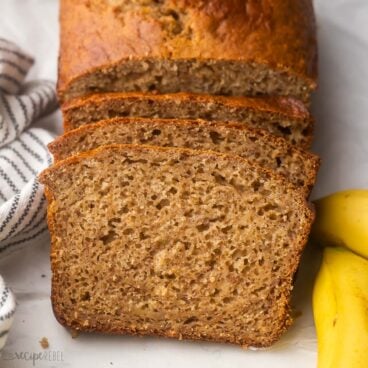How to Make an Omelette: easy, fool-proof instructions so you can make the perfect omelette every time! This recipe takes a total of 15 minutes and is super customizable!

Table of Contents
Omelettes are one of those foods that feel more complicated to make than they actually are. But really, at its simplest, an omelette is just eggs, maybe a couple seasonings, and (hopefully) cheese cooked in a pan. That doesn’t sound too complicated does it?
Although omelettes are simple, they are also pretty easy to mess up. Which is why I’m here to show you the perfect way to make an omelette.
This recipe is made of pantry staples with so many options to customize. Add meat, veggies, seasonings, your favorite cheese, you name it! The omelette is your oyster…or whatever the saying is. 😉
Looking for more savory breakfast ideas? Check out Easy Instant Pot Egg Bites, Quiche Lorraine, Breakfast Skillet, or this fun Breakfast Pizza!
Omelette Ingredients:
- Eggs: make sure the yolks and the whites are fully whisked together before you make the omelette.
- Milk: this is optional but makes for a creamier omelette! You can use any kind of milk you like. You can also opt for cream for a richer flavor.
- Seasonings: I use a simple salt and black pepper duo but other seasonings will work as well. Feel free to experiment!
- Cheese: Use your favorite. You can’t really go wrong! Feta, cheddar, parmesan, Swiss, goat cheese, pepper jack, mozzarella, you name it.
- Chives: I like to use freshly chopped chives as a garnish. Feel free to use other fresh herbs like parsley or cilantro instead.

How to make an omelette
This omelette recipe is ready in a total of 15 minutes!
- Mix: Whisk together eggs, milk, and seasonings.
- Cook: Melt butter in a skillet, then add in the egg mixture. When the eggs start to set, lift the cooked edges of the omelette and tilt the pan so the uncooked eggs run to the outside and underneath. Do this until the eggs are mostly cooked.
- Add toppings: Top half of the omelette with cheese and chives, then fold the other half over the top. Let the cheese melt, then serve garnished with more fresh chives!




Omelette FAQs
Either one! I like to use a splash of milk to create a creamier texture, but if you mix a touch of water in, the steam will cause the eggs to puff up which results in a fluffier omelette. You can definitely do whatever you prefer!
Definitely! If you want to swap the whole eggs out for just egg whites, you’ll need 2 egg whites (which is equal to ¼ cup) for every 1 egg called for. So for this recipe, I call for 2 large eggs. If you use egg whites, you’ll need 4.
A non-stick skillet is the way to go since you need to be able to move the omelette around and fold it over. I use an 8″ skillet which was perfect for the 2 eggs in this recipe. If you’re using 3 eggs, I recommend using a 9″ skillet.
Yes! Leftover omelette will last in an airtight container in the fridge for 3-4 days or in the freezer for up to 3 months. To reheat, cover and cook in the microwave for 1-1 ½ minutes or warm on the stove until heated through.

Variations on this Omelette recipe
Remember, if you’re adding in meat or veggies: pre-cook them! You can add the mix-ins at the same time you add the cheese and chives.
- Add veggies. Add in diced tomatoes, mushrooms, chopped spinach, onion, bell peppers, kale, any of your favorites.
- Add meat. Try diced ham, bacon, breakfast sausage, or even smoked salmon.
- Spice it up. You can keep it simple with just salt and pepper or spice it up with paprika, chili powder, garlic powder, cayenne pepper, red pepper flakes, or any dried herbs you like!
- Use other toppings. Omelettes are delicious topped with sour cream, salsa, guacamole, or hot sauce.

Tips, tricks, and notes for this recipe
- Whisk thoroughly. You want the egg mixture to be consistent in color so the yolks and whites are completely incorporated.
- Pre-cook mix-ins. Veggies release moisture as they cook. Meat also releases oil as it cooks. If you’re mixing in either of these things, make sure those add-ins are pre-cooked because they won’t cook well once they’re added.
- Don’t over-fill. Add-ins are great but make sure you don’t go overboard. If the omelette is too full, it will just fall apart. It will still be delicious!
- Use a non-stick skillet. Trust me. This makes it so much easier to move the omelette around.
- Smaller is sometimes better. Fewer eggs makes it more likely that no part of the omelette is left uncooked. A couple smaller omelettes is better than a big one!
- Preheat the pan. The omelette cooks more evenly if the pan is hot before you add it in.
- Cook on low heat. I cook my omelette on medium-low heat which works perfectly. If you cook on high heat, the outside of the omelette will burn before it’s cooked all the way through.
Serving suggestions
Omelettes make the perfect healthy breakfast on their own or you can bulk your meal up with air fryer potato wedges, whole wheat pancakes, air fryer bacon, strawberry banana smoothies, or any of your favorite breakfast recipes!
How to Make an Omelette
Ingredients
- 2 large eggs
- 2 tablespoons milk (optional — skip for dairy free)
- 1-2 pinches salt
- 1 pinch black pepper
- 1 tablespoon unsalted butter
- 2-3 tablespoons shredded cheese (any kind)
- 1-2 tablespoons fresh chopped chives
Instructions
- Whisk together eggs, milk, salt and pepper (season more or less according to your tastes).
- Melt butter in an 8" skillet (I prefer to use non-stick) over medium-low heat.
- When butter is melted, add eggs to the skillet. When the eggs begin to set, use a spatula to gently lift the cooked edges of the omelette and tilt the pan so that the uncooked eggs run to the outside and underneath.
- Do this a few times until the eggs are mostly cooked but still somewhat soft in the center.
- Place cheese and chives on half of the omelette and gently fold the other half over top. Turn the heat off and allow the cheese to melt for a couple minutes.
- Gently slide the omelette out and onto a plate to serve, garnishing with fresh chives as desired.
Notes
- Whisk thoroughly. You want the egg mixture to be consistent in color so the yolks and whites are completely incorporated.
- Pre-cook mix-ins. Veggies release moisture as they cook. Meat also releases oil as it cooks. If you’re mixing in either of these things, make sure those add-ins are pre-cooked because they won’t cook well once they’re added.
- Don’t over-fill. Add-ins are great but make sure you don’t go overboard. If the omelette is too full, it will just fall apart. It will still be delicious!
- Use a non-stick skillet. Trust me. This makes it so much easier to move the omelette around.
- Smaller is sometimes better. Fewer eggs makes it more likely that no part of the omelette is left uncooked. A couple smaller omelettes is better than a big one!
- Preheat the pan. The omelette cooks more evenly if the pan is hot before you add it in.
- Cook on low heat. I cook my omelette on medium-low heat which works perfectly. If you cook on high heat, the outside of the omelette will burn before it’s cooked all the way through.
Nutrition Information
Want to save this recipe?
Create an account easily save your favorite content, so you never forget a recipe again.
Tried this recipe?
Tag @thereciperebel or hashtag #thereciperebel — I love to see what you’re making!
Tag @thereciperebel





Leave A Reply